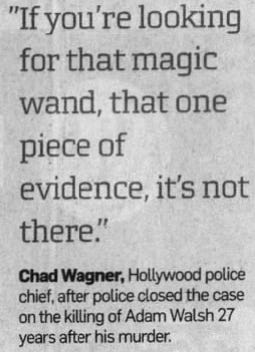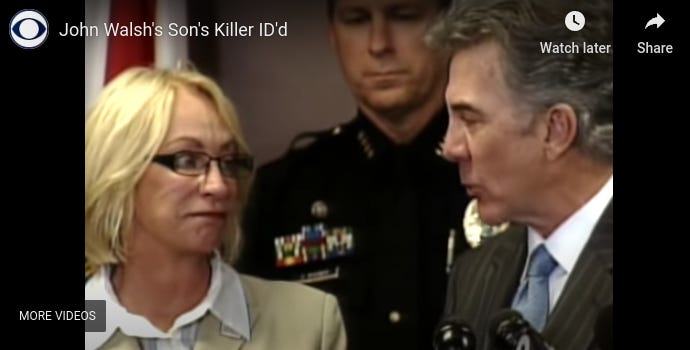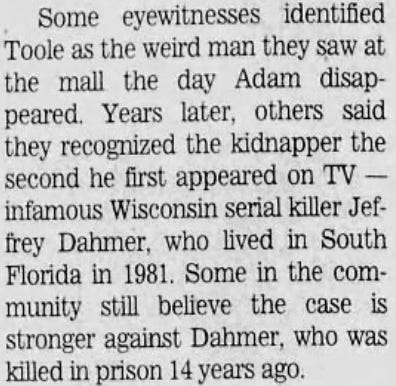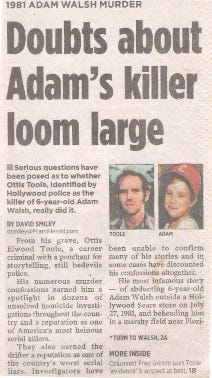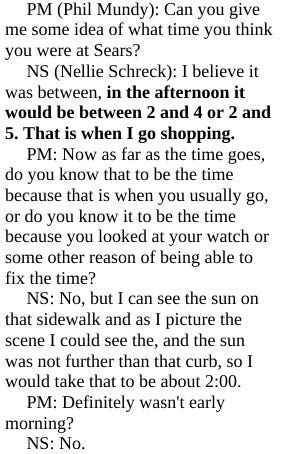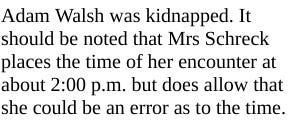The Unsolved Murder of Adam Walsh - 33
Episode 33: Resolution. The case ends. (Yeah, right.)
Link to Episode 32: The ABC Primetime show about Dahmer’s connection to Adam
Or start at the series beginning and binge from there: (Link to Episode 1)
The morning of December 16, 2008, Geoff Martz called me. Hollywood Police Chief Chad Wagner had just announced he would hold a press conference that afternoon at the police department to close the Adam Walsh case.
Really. On who? Dahmer?
Oh, sure.
Or maybe, Yeah, right.
It was Ottis Toole.
I told Willis Morgan about it so he could come too – but I made him agree not to say anything while the event was on, nor would I. Willis later got mad at me for that. He was dying to make a scene. I didn’t blame him, I just didn’t think it was a good idea.
The event seemed like a Christmas gift to John, Reve, and their three children, who were all on the dais. At last they could have closure, the killer of their son and older brother they’d never met, taken 27 years before from the shopping mall across the street from the press conference at the police station, finally determined. The event was carried live on all three cable news networks. In the room the media had an edge of skepticism, but it seemed inappropriate to argue with the tearful victims.
This wasn’t an easy question to ask, under the circumstances, but it was what every reporter in the room, at least for the local press, wanted to know. Finally, someone did – not me: Was there new evidence against Toole?
Wagner said “our investigation” placed Toole in Hollywood around the time of Adam’s abduction. No one followed up to ask him what that evidence was.
Joe Matthews was on the dais, too, and credited by Chief Wagner with conducting “an independent review and investigation” of the case. “I agreed with the ultimate conclusion of this independent investigation, that Ottis Toole was the perpetrator of this crime.”
That told me what the evidence was.
Matthews had told Geoff Martz he disbelieved the Dahmer theory because “you can’t rely on eyewitnesses.” The Toole witnesses, however, he’d apparently believed.
Mark Smith was also on the dais. What did he think of the decision? No way would I be the one to ask, but I was hoping someone would – and I’m sure Smith was hoping someone wouldn’t.
With just enough vigor, he said he agreed with it.
That contradicted what he’d told WSVN-Miami, broadcast February 1, 2007: “There are people who say they saw Jeffrey Dahmer. There’s more people that say they saw Ottis Toole, who I’m not totally convinced is involved in this case.”
National media presented the news as a good day for the Walshes. Bloggers generally agreed. Toole was dead, which meant that he could never be tried in court. And the Walshes felt so relieved.
And why not? It ended 27 years that the Walshes had blamed others: poor Kathy Shaffer, the 17-year-old security guard. Sears and Hollywood Mall, for not providing a safe environment for shoppers’ young children left alone by a parent. The Miami Herald, for recklessly mentioning there were rumors that the crime was drug-related (although the paper only quoted the cops in charge of the case saying that.) The FBI for not being involved in a missing child case (although I got the FBI case file as a public record, which showed they were keeping a close eye.) Hollywood Police, repeatedly, especially Jack Hoffman. The Mobile Press-Register for suing to get access to a police case file that a state statute said they were legally entitled to. And the judge for following the law on that. And the local press for not adequately covering the story in the first two weeks, not until the head was found.
So did it matter?
May I speak up? Thank you. Closing a murder case on a dubious, if convenient suspect, doesn’t inspire confidence in the police. Endorsing it based on their say-so didn’t make for the national media’s most shining day, either.
But a lot of the local media dissented. Within hours, this:
Well, it sure is nice to clear this case from the file room! Ottis Toole killed Adam Walsh, says Hollywood Police Chief Chad Wagner, citing approximately zero nuggets of new information.
This is either some great detective work... or it's a police chief eager to close an infamous, mangled, 27-year-old child abduction case.
An hour later, WSVN aired Questions Still Surround Adam Walsh Case After Its Official Closure. On tape, outside the police station they quoted me on camera: “I came here because they said they had new evidence. There was no new evidence.”
The next morning, The Miami Herald wrote:
Two days later, the Associated Press ran this, reprinted across the country:
Another week later, The Miami Herald led a Sunday paper with this:
I’d felt targeted by the press conference although my name never came up. But on the way out, there was some swag that far outweighed the indignity:
For the previous two years I’d repeatedly asked Hollywood to open the remainder of its case file, everything in it since the 1996 release, as a public record. Florida state statutes require the police to make their files available on request unless the case is in active investigation with an arrest or prosecution in the foreseeable future. I kept arguing it wasn’t. They kept saying it was. But maybe my pressure, between the requests and my news stories, got them to do this. Now, with the case officially closed, they had to open it. In fact, they’d prepared copies of it on CD-ROM to hand out to reporters. Because I was there I got a copy. One CD had everything that had been released in 1996, a second everything since then.
One of the most notable things about the case had been that police for years had not felt they had any credible witnesses, aside from Reve Walsh, who said they’d seen Adam at Sears that day. Actually, they had Timothy Pottenberg, he was the 10-year-old whose information in the first days had inspired the police to search for blue vans. The police hadn’t released his name to the press, and within a month they’d dismissed him, Jack Hoffman thought his timeline of what he saw was an hour too late.
In 1983, the Mayers, mother and daughter, had said they’d seen Toole, but that was at KMart, not Sears. In 1991 came William Mistler, but neither Hoffman, Mark Smith, nor Phil Mundy had considered him credible enough. Like Pottenberg and Mistler, Bill Bowen had reported seeing Adam and an abductor, but he had been dismissed. Willis Morgan hadn’t seen Adam at all, just a possible abductor.
So in the end, what was this vaunted case against Ottis Toole? Besides his confessions. There was Mary H.’s statement to Mundy in 1996 – from the new files we learned her full name was Mary Hagan, but she’d since died, in 2006, at age 85. There was little more in the transcript of her interview with Mundy than he’d told me in 1997.
There was Bobby Lee Jones, who said he’d worked with Toole in 1982 and was with him in the Duval County Jail in 1983. Jones said Toole described a number of locations on or near Hollywood Blvd., all of which were accurate. Mundy had re-interviewed him in 1996, but again, he’d already told me most everything in that statement. And then-security guard Kathryn Shaffer, now Kathryn Shaffer-Barrack, had changed her mind by 1996 to say that she’d thrown Adam out of the store. Whether her initial or revised impressions were correct, we knew in 1997 what she had said.
There was one new name, Nellie Schreck, a 76-year-old woman who when the case file was first opened in February 1996 had called Hollywood Police to tell what she’d seen at the mall on the day Adam was taken. In September, Mundy met her at her home in Hollywood.
Entering Sears near the layaway desk, she said a man had held the door open for her. She remembered his “egg-shaped head,” and “sparse hair, one eye that was slightly turned, protruding teeth, wearing I believe a plaid or very dark shirt.” She said he was very ugly and seedy-looking, and he “kind of tilted his head.”
It well-described Toole, from photos or video of him.
Just before she’d called Hollywood she’d seen Toole’s photo in the news, and was sure that was who she saw. For Mundy, she picked out his picture from a photo lineup of six. She hadn’t seen Adam.
Toole’s picture was first published in 1983, and she’d taken thirteen years to come forward. But there was an even bigger problem:
By 2 o’clock that day, the search for Adam was already well under way.
Although Schreck didn’t say this during her taped interview, Mundy added:
By the time the case file was made public in 2008, Schreck had died two years earlier, at age 86.
In 1995, when I’d first approached this story, I’d speculated that the police had the solution in their files, they just didn’t know it.
Thirteen years later, in the first weeks of 2009, I realized I’d been right.
I began going through Hollywood’s new CD that first night I got it. Immediately, I saw at least four more witnesses who’d said they’d seen Adam at Sears that day – all of whom Hollywood had dismissed. Two had seen Adam with his apparent abductor, the others had seen a suspicious man nearby him. Their statements were dated in 1996 and 1997. As I found each of them in the file, I located and interviewed them.
Phil Mundy hadn’t told me about any of them. He’d interviewed three and showed them the same six-picture photo lineup that included Toole; none identified him as the man they’d seen that day. On that, Mundy seemed to have dismissed each as a significant witness.
A fourth witness’s statement was on a tip sheet page from America’s Most Wanted forwarded to Hollywood Police. Neither Mundy nor Mark Smith had interviewed her. Was that because she’d mentioned seeing a blue van outside Sears? And Mundy was looking for an old white Cadillac?
When I interviewed them, individually, I showed each one a photo of Toole. All four had seen him before. The three who hadn’t identified him for Mundy emphatically told me that the man they saw wasn’t Toole. The fourth, who hadn’t been interviewed, thought maybe that was who she’d seen.
Then I showed pictures of Dahmer. All four knew who he was, although one didn’t know his face.
What happened next, I have never experienced anything like:
Each of the four reacted. The woman who thought she’d seen Toole got goosebumps. I saw them. It was Dahmer, she realized, not Toole who she’d seen. Another woman cried at the mention of Dahmer’s name. Seeing his picture years before she had concluded it was him, and she identified the first photo of him I showed her.
A man who was nine years old in 1981 and said he’d been playing videogames with Adam and saw him leave with a man, stared at a picture of Dahmer I showed him. His voice broke and tears came. Although he wouldn’t say absolutely it was Dahmer he’d seen, he admitted getting emotional. “You know what’s bothering me?” he asked. “That it’s bothering me.”
Another man did a double take when I first showed him Dahmer’s picture. He was skeptical that he was the same man he’d seen until a couple weeks later, when we looked at a number of photos of Dahmer on the Internet. He came to one and stopped.
“Oh, my god,” he said. “You have a picture that is strikingly similar to the man I saw.” He said if Mundy had shown him that picture in a lineup, he would have picked him out.
What’s more, two of the four, entering Sears that day, saw a blue van parked in the store’s fire lane just in front of the toy department entrance. Police had dismissed similar statements by Timothy Pottenberg and then Bill Bowen, but now there were four witnesses total who had seen a blue van in the same spot all at about the same time.
Next on Adam Walsh: America’s Missing Child:
You’re really far now, you’ll want to keep reading, there’s so much more about this story you had no idea about. And now we’re getting into the Jeffrey Dahmer section. FOLLOW, or SUBSCRIBE now for FREE and you won’t miss any new episode. But if you’re the type who pays for subscriptions on Substack, maybe you might consider me too? (I wouldn’t mind in the least.)
#true crime, #truecrime, #cold case, #katie, #terry, @meidas, @paul, @joy, @robert, @gavin, @sharyl, @aaron, @bulwark, @lincoln, @popular, #investigative


